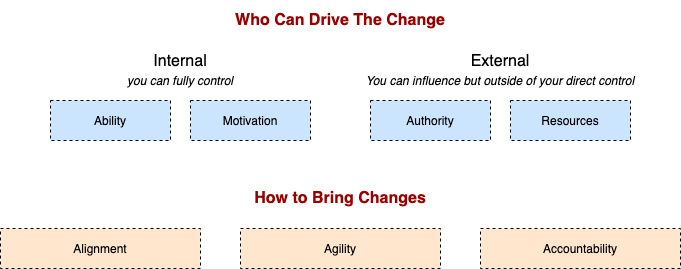Bringing Change To Organizations
To bring change to the organization you need the vision of how to do it. That’s why aligning an organization on vision and goals is the first thing you must focus on. Then, you need to use agility and accountability to succeed.

Change is hard. We resist it in our personal lives because it requires energy and effort. Some changes require adjusting how we think. Others mean creating new behaviors and habits. But most fundamental changes require both — a new way of thinking and new behaviors or habits.
It’s much easier to sustain our current thinking and behavioral patterns because they are constantly reinforced with repetition. To conserve energy, our brain falls into a default habitual mode. The neural networks are formed and become stronger as we repeatedly practice a certain behavior or way of thinking. That’s why creating new habits is so difficult. The brain has to build new neural pathways that over time can override the existing pathways responsible for our current habits.
All of us have made an effort to change ourselves. Our long term success, health, and happiness are directly related to how well we can adapt, evolve, and change ourselves through new thinking and behavioral patterns. Yet still, with the stakes so high, we often fail in our efforts.
Bringing changes to an organization is even harder. If you think it’s difficult to change your own behavior, imagine how hard it is to change the behaviors and habits of many people in an organization. Strategies and processes have been formed and repeated over time and have involved multiple people and departments. Companies have their own habitual ways of doing things.
Often companies hire people from outside the organization to be agents of change. The hope is that new hires, because they are not part of the current processes, can more clearly see the company’s deficiencies and limitations. Having a fresh perspective is crucial in identifying the necessary changes.
While working as a consultant, I have come to realize that my primary goal is to bring change to an organization. If it’s done right, positive outcomes will follow. The outcomes are always a byproduct of the process. At one point I decided to take a hard and honest look back at the work I have done to understand why certain projects were successful while others failed. I not only wanted to learn how to improve my work but also to identify the criteria I should use to decide what projects to take on.
Who drives the change
Every successful engagement in my consulting had four elements: ability, motivation, authority, and resources.
Ability refers to the skills needed to make changes or achieve goals. Every challenge and every project requires a unique set of skills and experiences to understand what needs to be done and, more importantly, how to make it happen. It's about your area of expertise and skills, knowledge, and experience related to it.
Motivation refers to the desire to take on a challenge or a project. Motivation is important because it not only drives the energy and enthusiasm but also enables you to enhance the skills needed to make the change a success. If you have a skills gap and are motivated you will expand your skills to ensure you put everything behind reaching the outcomes you desire. But if you have all the skills required to complete a project but no motivation to take it on, for whatever reason, you are unlikely to succeed.
Authority refers to the ability to make decisions or have a substantial voice in the decision-making process. You can’t bring change and provide positive outcomes if you can’t influence important decisions. For example, if the company founders or C-level executives aren’t involved in creating strategic messaging or a brand story there’s no way to make it work. You can spend an enormous amount of time and effort coming up with new messaging only to encounter resistance from executives. For the most part, the outcome of strategic messaging and story creation is not the framework or exact wording but a body of exercises and conversations. As you follow the process of creating messaging or a story you understand the outcome. If you are only presented with messaging without the context of the process you won’t have a full understanding of why the messaging looks the way it does, or why it’s important.
Resources refer to all the investments required to achieve a particular outcome. Even if you know what to do and have the skills, are motivated, and have the authority to make decisions, you still need the resources to make it happen. Resources include people with the right skills, capital, and tools. You need people to help you, financial capital, and tools to get you there.
You can control and evaluate your ability and motivation but you can’t control the authority and resources. Those last two are mostly determined by forces outside of your direct control.
- Ability: Do I know what needs to be done and how to do it?
- Motivation: Do I feel excited about the project?
- Authority: Will I be able to make or influence important decisions?
- Resources: Will I have the minimum set of resources required to make the change?

This framework is helpful for more than evaluating a consulting project. You can also use it to evaluate a job opportunity. Do I have the basic skills necessary to succeed in this position? Am I motivated to do what’s demanded and invest time and effort to improve my skills and knowledge? Will I be able to make or influence important decisions? And, finally, will I be provided with a minimum set of resources to succeed in this position?
In order to succeed with any project, you have to have all four elements. Use this four-step framework to evaluate your new assignment, new job opportunity, or a new project.
How to incorporate change
Until now we have discussed the four elements to evaluate the probability of bringing change, whether it comes from you or someone else. Now, let's say you have all four. How do you go about making a change in the organization? What should you focus on?
To bring change to the organization you need the vision of how to do it. That’s why aligning an organization on vision and goals is the first thing you must focus on. Then, you need to use agility and accountability to succeed.
Alignment: same vision and goals
Alignment is about communication. It’s essential because in order for an organization to change, everyone must understand why change is necessary and what outcomes it will bring. If people have not bought into the vision you will have a hard time getting to the promised land. Organizational change is difficult and requires adjusting systems and processes. People need to think and act differently. And without understanding the mission and reason for the change it’s almost impossible to get the wholehearted commitment from the team members and across the organization.
There is a set of beliefs and assumptions that shapes the system. That’s why corporate culture is so important. It’s the default framework of values that guides everyone in the organization on how things are done. You can’t bring change if you don’t change the underlying beliefs that led to past behaviors. The most radical changes can be addressed only through modifying corporate culture.
Agility: quick actions and quick feedback loops
In order for everyone in an organization to stay motivated and focused, you must move quickly. Certainly, some projects require execution for a substantial period of time. However, breaking it down into small projects and quick wins allows the team to celebrate and see progress. Outcomes don’t have to be large. A daily one percent improvement is what you should be striving for. In 72 days your improvement will double (rule of 72).
Moving fast not only refers to actions. The speed of implementation is important, but so is the speed of decision making. The world is changing fast and it’s not always clear whether a decision is right or wrong. Nonetheless, a slightly wrong decision made quickly is often better than the right decision that’s delayed.
Decision making process is a series of tradeoffs. You want to minimize the risk of bad outcomes while maximizing the upside. Creating a framework for how certain decisions are made will improve agility. You need to anticipate certain kinds of setbacks and have a process to address them. Often there is no such thing as a wrong or right decision. The best way is to think about decisions as bets and probabilities. Consistent and agile execution of a suboptimal plan beats perfect and slow execution of a perfect plan. James Clear, the author of Atomic Habits, summarized it well:
"The optimal strategy might be executing a suboptimal plan at a fast pace. Strategy evolves as lessons are learned—and the person who moves faster, learns faster. Learning is a marathon and perfection is a weighted vest."
Accountability: ownership and decision making
Accountability is a must-have to execute well. It starts with identifying all the parties responsible for the different parts of the initiative. We discussed that in order to bring the change you have to have the authority to make decisions and the resources. It’s difficult to be accountable without both present. There is nothing more frustrating than having responsibility for the outcome without the ability to make decisions or without resources.
Managing and enforcing accountability is another challenge. When you are driving change in the organization, evaluate every key player to ensure that they have the authority and resources to be accountable for their outcome and performance. However, it also helps to have people with the right abilities and motivation to be effective.
Bringing systemic change to an organization is extremely difficult. It requires rewiring the organization with new ways of thinking and new processes. The agent of change has to have the ability and motivation to execute. And he/she needs to be provided with the authority to make decisions and resources to achieve the goals.
Having the right person driving the change is not enough. To change any organization you need to ensure that everyone is aligned around the visions and goals for the change. You have to move quickly and prove the necessity of change with small but strategic wins. You must be agile in your execution. And finally, the organization has to understand who is accountable for what outcome and who makes what decisions.
Reflect on your professional successes and failures. Why did you succeed? Was it because you had all four elements in place? Why did you fail? Was it because you weren’t motivated, or you couldn’t make decisions, or because you didn’t have the resources?
Please share your experiences of driving change (@mykpono). What principles do you follow to improve your chances of bringing change? Also, please share any books, articles, or links on this or related topics.
Related Resources
Books:
- Atomic Habits by James Clear
- The Effective Executive by Peter Drucker
- The CMO Manifesto by John F Ellett
- What You Do Is Who You Are: How to Create Your Business Culture by Ben Horowitz
If you like this article please recommend and share it, and join my newsletter.
